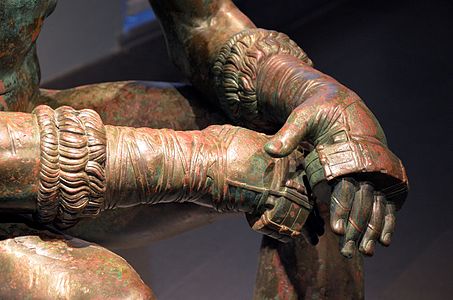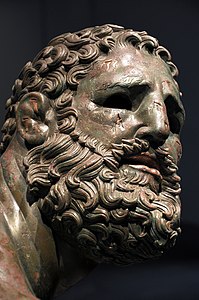art.wikisort.org - Sculpture
The Boxer at Rest, also known as the Terme Boxer, Seated Boxer, Defeated Boxer, or Boxer of the Quirinal, is a Hellenistic Greek bronze sculpture of a sitting nude boxer at rest, still wearing his himantes, a type of leather hand-wrap. It has been given various dates within the period of about 330 to 50 BCE. It was excavated in Rome in 1885, and is now in the collection of the National Museum of Rome, normally displayed in the Palazzo Massimo alle Terme.[1]
| Boxer at Rest | |
|---|---|
| Terme Boxer, Boxer of the Quirinal | |
 | |
| Year | c. 330 to 50 BCE |
| Medium | Bronze statue |
| Location | Palazzo Massimo alle Terme, Rome, Italy |
The Boxer at Rest is one of the finest examples of bronze sculptures to have survived from the ancient world; survivals from the period are rare, as they were easily melted down and transformed into new objects. The work comes from a period in Greek art where there is a movement away from idealized heroic depictions of the body and youth, and an exploration of emotional as well as psychological themes and greater realism. These traits are typical of Hellenistic art and thoroughly displayed in this sculpture, making it a hallmark of the Hellenistic style.
Discovery
The Boxer is one of two unrelated bronzes (the other being the unidentified Hellenistic Prince) discovered on the slopes of the Quirinal within a month of each other in 1885, possibly from the remains of the Baths of Constantine. It appears that both had been carefully buried in antiquity. The archaeologist Rodolfo Lanciani, who was present at the sculpture's discovery, wrote:[2]
I have witnessed, in my long career in the active field of archaeology, many discoveries; I have experienced surprise after surprise; I have sometimes and most unexpectedly met with real masterpieces; but I have never felt such an extraordinary impression as the one created by the sight of this magnificent specimen of a semi-barbaric athlete, coming slowly out of the ground, as if awakening from a long repose after his gallant fights.
Description and Interpretation



The statue is a masterpiece of Hellenistic athletic professionalism, with a top-heavy over-muscled torso and scarred and bruised face, penis bound by a kynodesme, cauliflower ears, broken nose, and a mouth suggesting broken teeth.[1] The boxer was also depicted as bearded, which would have been a typical characteristic of ancient boxers.[3] R.R.R. Smith believes that the statue does not show a true portrait: this is genre realism, individuality removed in favor of a generic character of "boxer".[4] A reconstruction project executed by the Frankfurt Liebieghaus Polychromy Research Project and headed by Vinzenz Brinkmann follows the interpretation of Otto Rossbach (1898)[5] and Phyllis L. Williams (1945)[6] and identifies the statue as Amykos, King of the Bebryces.[7][8]
In 1989, both bronzes were meticulously conserved by Nikolaus Himmelmann, in preparation for their exhibition at the Akademisches Kunstmuseum in Bonn.[9] The sculpture is soldered together from eight segments, separately cast through the lost-wax process; the joins have been filed and finished to be virtually invisible. The lips and wounds and scars about the face were originally inlaid with copper, and further copper inlays on the right shoulder, forearm, caestus and thigh represented drops and trickles of blood. The fingers and toes were worn from being rubbed by passers-by in ancient times, which has suggested that the Boxer was carefully buried to preserve its talismanic value, when the Baths were abandoned after the Goths cut the aqueducts that fed them.[10] These baths remained mostly unused until the 6th and 7th century when Pilgrims being treated nearby in the Xenodochium of Santi Nereo ed Achilleo were buried at the location of the baths.[11]
The statue was displayed in the United States for the first time from June to July 2013 at the Metropolitan Museum of Art in New York City as part of the "Year of Italian Culture in the United States".[12]
Reception
| External video | |
|---|---|
 | |
The literary and aesthetic reception of the statue continues to be of high regard for its aesthetic virtues. In 1991, Thom Jones wrote "The Pugilist at Rest", a short story which includes the aesthetic reflection upon the statue's rare quality as seen through the eyes of a worn and weary boxer contemplating its inspiration. He suggested that the sitter may be the famed Ancient boxer, Theogenes. During the time of its display in New York during the summer of 2013 (ended 20 July), New York magazine published on 15 July 2013 a full page dedication to the special qualities and attributes of the statue.
Jerry Saltz, the author of this magazine article enumerated the six distinctive features of the statue as follows: (i) The Pose, distinct for its massiveness and "elemental" form, (ii) The Face, noted for the large brow and columnar neck, (iii) The Blood, noted by its inlaid copper upon the bronze statue itself, (iv) The Scarred Genitals, distinct for being infibulated for cultural and aesthetic purposes of ancient times, (v) The Hands, noted for being astounding yet gentle at the same time, and (vi) The Foresight, referring to the sculptor's strength of vision which resembles and conjures Goya's Giant as well as comparison with "Velazquez and Rembrandt", as Saltz completes his list.
The Italian poet Gabriele Tinti has written essays and some poems on sculpture and presented a series of readings in front of the statue at the J. Paul Getty Museum with the actor Robert Davi and at the National Roman Museum with the actor Franco Nero.[14] On 2 August 2019, American actor Kevin Spacey read Tinti's poetry inspired by the statue at the National Roman Museum in Palazzo Massimo.[15]
References
- Gardner, Helen; Kleiner, Fred S. (2013). Gardner's art through the ages: a global history (14th [revised and enlarged] ed.). Australia. ISBN 978-0-8400-3078-8. OCLC 894921256.
- Lanciani, Ancient Rome in Light of Recent Discoveries (1888:305–306), quoted in Sean Hemingway, "The Boxer: an ancient masterpiece comes to the Met", 2013; accessed 29 June 2013.
- Arenas, Amelia (1999). "The Boxer". Arion: A Journal of Humanities and the Classics. 7: 120–126 – via JSTOR.
- Smith, R. R. R. (1991). Hellenistic Sculpture. London. pp. 54–55.
- Otto Rossbach: Amykos. In: Festschrift für Otto Benndorf zu seinem 60. Geburtstage gewidmet von Schülern, Freunden und Fachgenossen. A. Hölder, Vienna 1898, pp. 148–152 (digital copy).
- Phyllis L. Williams: Amykos and the Dioskouroi. In: American Journal of Archaeology. Bd. 49, Nr. 3, 1945, S. 330–347, doi:10.2307/499627
- Vinzenz Brinkmann, Ulrike Koch-Brinkmann: Die sogenannten Quirinalsbronzen und der Faustkampf von Amykos mit dem Argonauten Polydeukes. Ein archäologisches Experiment. In: Vinzenz Brinkmann (ed.): Medeas Liebe und die Jagd nach dem Goldenen Vlies. Exhibition catalogue Liebieghaus Skulpturensammlung, Frankfurt 2018. Hirmer, Munich 2018, p. 80–97.
- https://youtube.com/watch?v=jHvemlFGMkA, The Quirinal Bronzes reconstruction project (Making of) on YouTube
- Himmelmann, Nikolaus (1998). Herrscher und Athlet: Die Bronzen vom Quirinal. Milan: Olivetti.
- Hemingway 2013.
- Piranomonte, Marina (2008). The Baths of Caracalla : guide. Italy. Soprintendenza speciale per i beni archeologici di Roma (1st ed.). Milano: Electa. ISBN 978-88-370-6302-3. OCLC 233929517.
- "Art - June 2013 - Italy in US 2013: Year of Italian Culture in the United States". italyinus2013.org. Archived from the original on 20 June 2013.
- "Apollonius's Boxer at Rest". Smarthistory at Khan Academy. Retrieved February 18, 2013.
- https://www.youtube.com/watch?v=379fr-ZlMQQ, National Roman Museum
- "Kevin Spacey Reads Poem About Dejected Boxer at Rome Museum". Hollywood Reporter. 2 August 2019. Retrieved 2 August 2019.
External links
- 3D preview at Sketchfab
На других языках
[de] Faustkämpfer vom Quirinal
Der Faustkämpfer vom Quirinal (häufig auch Boxer vom Quirinal genannt) in Rom ist wohl die bemerkenswerteste erhaltene Bronzestatue eines solchen Athleten – und eines von nur sehr wenigen überlieferten griechischen Originalen. Die Datierung schwankt zwischen dem späten 4. Jahrhundert v. Chr. und der Mitte des 1. Jahrhunderts v. Chr. Die Plastik befindet sich heute im Museo Nazionale Romano in Rom unter der Inventarnummer 1055.- [en] Boxer at Rest
[es] Púgil en reposo
El Púgil en reposo o Púgil de las Termas es una escultura de bronce de 1,20 metros de altura. Encontrado en las termas de Constantino, en Roma, actualmente se conserva en el Palazzo Massimo alle Terme, una sección del Museo Nacional Romano. Es una de las dos obras encontradas en 1885 con tan sólo un mes de diferencia en las laderas de la colina del Quirinal,[1] posiblemente procedentes de las ruinas de los baños de Constantino. Parece que las dos fueron enterradas esmeradamente ya en la antigüedad. El realismo de la pieza sugiere que es algún boxeador en particular y no la representación de Polideuco, uno de los Dioscuros.[it] Pugile in riposo
La statua bronzea del Pugile in riposo, conosciuta anche come Pugile delle Terme o Pugile del Quirinale, è una scultura greca alta 128 cm, datata alla seconda metà del IV secolo a.C. e attribuita a Lisippo o alla sua immediata cerchia[1]; rinvenuta a Roma alle pendici del Quirinale nel 1885, è conservata al Museo Nazionale Romano (inv. 1055).[ru] Кулачный боец (Квиринал)
«Кулачный боец», «Квиринальский боец», «Кулачный боец из терм», «Статуя отдыхающего боксёра» (итал. Il pugilatore in riposo, Pugile delle Terme, Pugile del Quirinale) — редкий пример сохранившегося бронзового оригинала, скульптуры эллинистического периода. Датируется I веком до н. э. По иным мнениям является произведением эпохи поздней классики школы Лисиппа IV в. до н. э. [1].Другой контент может иметь иную лицензию. Перед использованием материалов сайта WikiSort.org внимательно изучите правила лицензирования конкретных элементов наполнения сайта.
WikiSort.org - проект по пересортировке и дополнению контента Википедии


